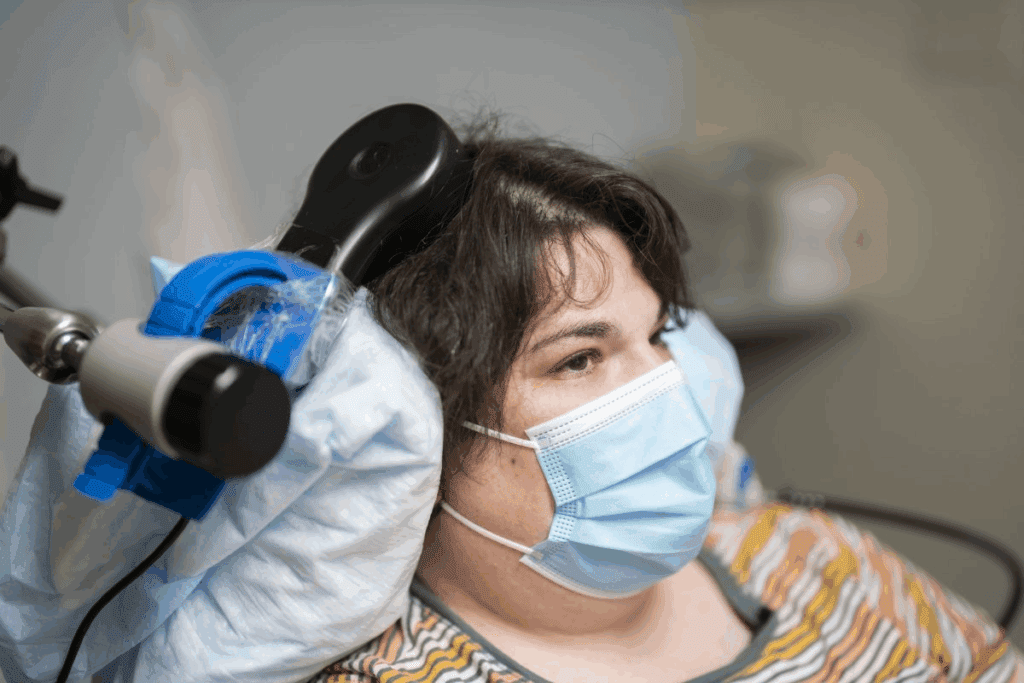Last Updated on November 26, 2025 by Bilal Hasdemir

At Liv Hospital, we know how vital safe and effective treatments for brain aneurysms are. Cerebral coiling is a new, less invasive way to treat brain aneurysms. It works by putting platinum coils into the aneurysm. This helps form blood clots, sealing off the aneurysm from blood flow.
This method has big advantages over old surgical ways. It means patients can recover faster, feel less pain, and face fewer risks. So, patients get a better, more comfortable treatment experience.
Key Takeaways
- Minimally invasive procedure for brain aneurysm treatment
- Promotes blood clot formation to seal off the aneurysm
- Faster recovery and less pain compared to traditional surgery
- Reduced risk of complications
- Effective treatment option for eligible patients
Understanding Brain Aneurysms and Their Risks

It’s key to know the risks of brain aneurysms for early detection and treatment. These are weak spots in brain blood vessels that can balloon and rupture. This can lead to serious health issues.
What Causes Brain Aneurysms
Genetic and environmental factors cause brain aneurysms. Genetic predisposition is a big factor, with conditions like polycystic kidney disease increasing risk. Other causes include hypertension, smoking, and atherosclerosis.
The exact cause of an aneurysm can vary. It’s often due to weaknesses in the blood vessel wall. Knowing these causes helps identify those at higher risk.
Signs and Symptoms of Brain Aneurysms
Many aneurysms don’t show symptoms until they rupture. But, symptoms like severe headache, nausea, vomiting, and loss of consciousness can occur. Unruptured aneurysms might also cause symptoms due to their size and pressure.
| Symptom | Description |
| Severe Headache | Often described as the worst headache of their life |
| Nausea and Vomiting | Can occur due to increased intracranial pressure |
| Loss of Consciousness | May happen if the aneurysm ruptures |
The Dangers of Aneurysm Rupture
A ruptured brain aneurysm is a medical emergency. It can cause subarachnoid hemorrhage, leading to severe brain damage or death. Immediate dangers include re-bleeding, vasospasm, and hydrocephalus.
Quick medical action is vital to prevent further issues and improve outcomes. Knowing the risks of rupture highlights the need for timely diagnosis and treatment.
Cerebral Coiling: A Minimally Invasive Approach to Aneurysm Treatment

Cerebral coiling is a new way to treat brain aneurysms. It’s safer than old surgery methods. This method uses platinum coils to stop blood flow and close the aneurysm.
Definition and Purpose of Endovascular Coiling
Endovascular coiling, or cerebral coiling, treats brain aneurysms without surgery. It fills the aneurysm with coils to stop bleeding. This method lowers the risk of rupture and helps the body heal.
The coils are made of platinum. This material is safe for the body and helps blood clots form. By filling the aneurysm, we seal it off from blood flow.
History and Development of the Procedure
Cerebral coiling is a big step forward in treating brain aneurysms. It started in the 1990s and has improved a lot. New coil designs and delivery systems have made it safer and more effective.
Over time, we’ve seen many coil designs and materials. These changes have made coiling a good option for more aneurysms.
When Coil Embolization is Recommended
Coil embolization is best for certain aneurysms. Doctors decide based on the aneurysm’s size, location, and shape. They also look at the patient’s health and medical history.
| Aneurysm Characteristic | Ideal for Coiling | Not Ideal for Coiling |
| Size | Small to medium | Very large or giant |
| Location | Accessible areas | Difficult to access |
| Shape | Saccular aneurysms | Fusiform or complex shapes |
We choose cerebral coiling for aneurysms hard to treat with surgery. It’s a less invasive option with fewer risks.
The Science Behind Aneurysm Coils and How They Work
To understand how aneurysm coils work, we need to look at their makeup and purpose. These coils are key in treating brain aneurysms through endovascular methods.
Platinum Coil Design and Materials
Aneurysm coils are made from soft, flexible platinum. This choice is due to platinum’s biocompatibility, strength, and ability to be shaped. It’s deployed through a microcatheter for precise placement in the aneurysm.
Key Features of Platinum Coils:
- Biocompatibility to minimize adverse reactions
- Flexibility to conform to the aneurysm’s shape
- Radiopacity for clear visualization during and after the procedure
How Coils Promote Blood Clotting Within Aneurysms
The main way aneurysm coils work is by encouraging blood clotting inside the aneurysm. After deployment, the coil fills the aneurysm, creating a base for clots. Over time, this makes the aneurysm less likely to rupture.
| Mechanism | Description | Outcome |
| Coil Deployment | Fills the aneurysm, providing a scaffold | Promotes clot formation |
| Clot Formation | Excludes the aneurysm from circulation | Reduces risk of rupture |
Types of Medical Coils Used in Brain Procedures
While platinum coils are the most used, other types exist for brain aneurysm treatment. Bioactive coils aim to boost clotting and healing. Stent-assisted coiling uses a stent to support the coil in the aneurysm.
Advancements in coil technology continue to improve the safety and efficacy of aneurysm treatment.
Step-by-Step: The Coiling Procedure Explained
Learning about the coiling procedure can ease worries for those with brain aneurysms. It covers several stages, from getting ready to aftercare.
Pre-Procedure Preparation
Before starting, patients go through preparations to ensure safety and treatment success. General anesthesia is given to keep them comfortable and calm. We also check their medical history and do imaging tests to guide the treatment.
The Catheterization Process
The catheterization step is key in the coiling process. A catheter is carefully guided through the blood vessels to the aneurysm site with real-time imaging. This step needs precision to avoid harming nearby vessels.
Coil Deployment Techniques
With the catheter in place, the next step is deploying the coils. Platinum coils are used because they work well with MRI scans and help clot the aneurysm. The coils are placed in the aneurysm to block blood flow.
Completion and Immediate Post-Procedure Care
After deploying the coils, we check the aneurysm to make sure the coils are in the right spot and there are no issues. Post-procedure care involves close monitoring in a recovery area to manage any side effects and ensure comfort. The patient then moves to a hospital room for more recovery and observation.
| Stage | Description | Key Considerations |
| Pre-Procedure Preparation | General anesthesia, medical history review, imaging tests | Patient safety, treatment success |
| Catheterization | Guiding catheter to aneurysm site | Precision, vessel integrity |
| Coil Deployment | Deploying platinum coils into aneurysm | Effective clotting, coil positioning |
| Post-Procedure Care | Monitoring, managing side effects | Patient comfort, complication management |
Comparing Endovascular Coiling to Surgical Clipping
Endovascular coiling and surgical clipping are two ways to treat brain aneurysms. Each method has its own benefits and drawbacks. It’s important for patients and doctors to understand these differences to choose the best treatment.
Invasiveness and Surgical Approach Differences
Endovascular coiling is less invasive than surgical clipping. It uses a catheter to reach the aneurysm and fills it with coils. This stops bleeding. Surgical clipping, on the other hand, requires open-brain surgery to place a clip at the aneurysm’s base.
Key differences in invasiveness:
- Endovascular coiling: Minimally invasive, no open surgery required.
- Surgical clipping: Requires open-brain surgery.
Recovery Time Comparison
Patients who get coiling recover faster than those who get clipping. Coiling is less invasive, leading to less tissue damage. This means quicker recovery times. Clipping, being more invasive, results in longer hospital stays and recovery periods.
| Treatment Method | Average Hospital Stay | Recovery Time |
| Endovascular Coiling | 1-3 days | 1-2 weeks |
| Surgical Clipping | 5-7 days | 4-6 weeks |
Success Rates and Long-Term Outcomes
Both coiling and clipping can effectively treat brain aneurysms. The choice depends on the aneurysm’s location, size, and shape. Each procedure has its own success rates and outcomes.
“The choice between endovascular coiling and surgical clipping should be made based on a thorough evaluation of the patient’s condition and the aneurysm’s characteristics.” When Clipping May Be Preferred Over Coiling
In some cases, clipping might be better than coiling. This is true for large, complex aneurysms or those hard to reach with coiling. Clipping is also chosen for patients at high risk of aneurysm recurrence or with other complications.
In conclusion, both coiling and clipping are valid options for treating brain aneurysms. The right choice depends on the patient’s needs and the aneurysm’s characteristics.
Key Benefits of Brain Aneurysm Endovascular Coiling
Patients with brain aneurysms can greatly benefit from endovascular coiling. This method is less invasive and has shown impressive results. It’s becoming more popular than traditional surgery for many reasons.
Reduced Recovery Time and Hospital Stay
Endovascular coiling leads to a much quicker recovery. Unlike open surgery, it doesn’t require a long hospital stay. This is because it’s less invasive, causing less damage and trauma.
Minimized Risk of Brain Injury
This method also lowers the risk of brain injury. It accesses the aneurysm through blood vessels, avoiding direct brain contact. This is great for sensitive or hard-to-reach brain areas.
Accessibility for Complex Aneurysm Locations
Endovascular coiling is excellent for treating complex aneurysms. New technologies in catheters and coils allow us to reach areas once thought unreachable. This has opened up more treatment options for complex cases.
Patient Comfort and Pain Management
Patient comfort is a key focus in endovascular coiling. The procedure is done under sedation or local anesthesia. This makes the experience more comfortable for patients. Plus, the procedure causes less pain after, making recovery easier.
| Benefits | Description | Advantages |
| Reduced Recovery Time | Less invasive, resulting in quicker healing | Faster return to normal activities |
| Minimized Brain Injury Risk | Avoids direct brain tissue contact | Lower risk of complications |
| Accessibility for Complex Locations | Advanced catheter and coil technology | Expanded treatment options |
| Patient Comfort | Sedation or local anesthesia used | Less post-operative pain |
Potential Risks and Complications of Coiling Aneurysms
The coiling procedure, like any medical intervention, carries certain risks. It is generally safe but can lead to complications. These can range from minor to severe.
Procedure-Related Complications
Complications can happen during or after the coiling procedure. These include thromboembolic events and aneurysm rupture. Both are serious and potentially life-threatening.
Other issues can occur at the access site. These include hematoma and pseudoaneurysm formation. Choosing the right patient and using precise techniques can help avoid these risks.
Coil Compaction and Aneurysm Recurrence
Coil compaction is a long-term risk of coiling. It can cause aneurysm recurrence. This happens when coils pack too tightly, leaving space for blood to refill the aneurysm.
Recurrence is a big worry. It may mean more treatment is needed. The size and shape of the aneurysm and how well it was coiled initially play a role.
Arterial Coiling Complications
Complications can happen when coils accidentally go into the parent artery. This can cause thrombosis or stenosis. These issues can be serious if not treated quickly.
Managing and Minimizing Risks
Reducing risks from coiling aneurysms needs a detailed plan. This includes choosing the right patients, being precise during the procedure, and good care after.
Using advanced imaging and intraoperative monitoring helps catch and fix problems early. Antiplatelet therapy and anticoagulation can also lower the risk of blood clots.
Knowing these risks helps doctors advise patients better. It helps make informed choices about treating brain aneurysms.
Recovery After Aneurysm Coil Embolization
Knowing what to expect after aneurysm coil embolization can help reduce anxiety. The recovery process includes immediate care, short-term limits, and long-term check-ups.
Immediate Post-Procedure Recovery
Patients are watched closely in a recovery area for hours after the procedure. Medical staff monitor vital signs and look for complications. Following your healthcare team’s instructions is key to a smooth recovery.
Some discomfort, like groin pain or headaches, may occur. These symptoms are usually managed with medication. Rest is essential during this time.
Short-Term Limitations and Care
Patients should avoid heavy lifting and strenuous activities in the short term. These precautions help prevent complications and aid in healing.
It’s important to know the signs of complications, such as severe headaches or weakness. Seek medical help immediately if these symptoms appear.
Long-Term Follow-Up Requirements
Regular follow-ups are vital after aneurysm coil embolization. Imaging tests, like angiograms or MRIs, are used to check the aneurysm’s status and for new issues.
| Follow-Up Procedure | Purpose | Timeline |
| Angiogram | To check the aneurysm’s status post-coiling | 6-12 months post-procedure |
| MRI | To monitor for any changes or complications | Annually or as recommended |
Living with Coils in the Brain
Living with brain coils requires some adjustments but doesn’t usually affect daily life much. Patients can usually return to normal activities within a few days to a week after the procedure.
Attending all scheduled follow-up appointments is important. It ensures the coils are working right and addresses any concerns or questions.
Who is an Ideal Candidate for Surgical Coiling Brain Aneurysm?
Choosing the right candidate for cerebral coiling is complex. We look at several key factors to see if coiling is a good option for brain aneurysms.
Aneurysm Characteristics Suitable for Coiling
The type of aneurysm is very important. Aneurysms that are usually good for coiling are:
- Small to medium in size
- Located in a spot that’s hard to reach for surgery
- Have a narrow neck, which helps with coiling
We also check the aneurysm’s shape and how it’s positioned. Aneurysms that are easier to coil are more likely to do well.
Patient Health Considerations
The patient’s health is a big factor. We look at their medical history, like high blood pressure, diabetes, and past vascular diseases. Some health issues can make surgery riskier.
People with serious health problems might not be the best fit for coiling. But, we look at each case carefully. We work with patients and their doctors to make the best choice.
Age and Other Demographic Factors
Age and other factors are also important. Age itself isn’t a reason not to have coiling. But older patients might face more risks. We consider the patient’s health and the aneurysm’s details to decide the best treatment.
Here are the things we think about:
- The patient’s age and health
- Any other health issues they have
- The size and where the aneurysm is
Discussing Options with Your Healthcare Provider
Deciding on coiling for a brain aneurysm should be a team effort. We talk with patients about their options, including coiling’s benefits and risks.
Knowing what makes someone a good candidate for coiling helps patients make informed choices. We aim to give personalized advice and support every step of the way.
Innovations and Future Directions in Aneurysm Coiling
The field of aneurysm coiling is changing fast. New technologies and a better understanding of blood vessels are driving these changes. These advancements aim to make treatments better for patients.
Flow Diverters and Stent-Assisted Coiling
Flow diverters are a big step forward in treating complex aneurysms. They help block blood flow to the aneurysm, leading to clotting and healing. Stent-assisted coiling uses a stent to support the coils in wide-necked aneurysms. This method makes more aneurysms treatable with endovascular methods.
Bioactive Coils and Healing Promotion
Bioactive coils are designed to help the aneurysm heal faster. They have coatings that encourage clotting and tissue growth. This makes the treatment more effective and lasting.
Emerging Technologies in Endovascular Treatment
New technologies are coming to endovascular aneurysm treatment. These include better catheters, imaging, and robotic-assisted interventions. These advancements will make procedures more precise and safe.
Research Advancements in Coiling for Aneurysm
Research is key to improving aneurysm coiling. Studies on long-term results and new materials are vital. They help doctors use the latest treatments to help patients.
Conclusion: Making Informed Decisions About Aneurysm Treatment
It’s important for patients to understand cerebral coiling and aneurysm treatment. Knowing the benefits, risks, and other options helps them choose the best treatment. This way, they can work with their doctors to find the right care for them.
Cerebral coiling is a key treatment for brain aneurysms. It’s a less invasive method that might have fewer side effects than surgery. The procedure uses coils to help the blood clot and stop the aneurysm from bursting.
When thinking about treatment, it’s key to consider the good and bad of cerebral coiling. Things like the size and location of the aneurysm and the patient’s health matter a lot. Talking to doctors about the latest in endovascular coiling helps patients make smart choices.
Understanding all the options for treating aneurysms is vital. This includes cerebral coiling and other endovascular methods. Patients should talk openly with their doctors to find the best treatment for their situation.
FAQ
What is cerebral coiling, and how does it treat brain aneurysms?
Cerebral coiling, or endovascular coiling, is a non-surgical way to treat brain aneurysms. It uses platinum coils to block blood flow into the aneurysm. This helps to stop the aneurysm from growing.
What are the benefits of endovascular coiling compared to surgical clipping?
Endovascular coiling has many advantages. It leads to quicker recovery times and less chance of brain damage. It’s also better for treating hard-to-reach aneurysms.
How do aneurysm coils promote blood clotting within aneurysms?
Aneurysm coils, made of platinum, fill the aneurysm and help blood clots form. This blocks blood flow into the aneurysm, preventing further bleeding.
What are the possible risks and complications of coiling aneurysms?
Risks include complications during the procedure, coil movement, and the aneurysm coming back. Choosing the right patient and using the right technique can lower these risks.
What is the recovery process like after aneurysm coil embolization?
Recovery starts right after the procedure. Patients face some restrictions at first but can gradually return to normal life. Close monitoring is key during this time.
Who is an ideal candidate for surgical coiling of a brain aneurysm?
The right candidate depends on the aneurysm’s size and location, the patient’s health, and other factors. Talking to a doctor helps decide the best treatment.
What are the innovations and future directions in aneurysm coiling?
New technologies like flow diverters and bioactive coils are being developed. These aim to make coiling safer and more effective.
What is considered a main benefit of endovascular coiling?
A key advantage is its minimally invasive nature. This reduces recovery time and lowers the risk of brain injury.
How does coil embolization work for treating brain aneurysms?
Coil embolization fills the aneurysm with platinum coils. This encourages clotting and blocks blood flow, effectively treating the aneurysm.
What are the signs and symptoms of brain aneurysms?
Symptoms can include severe headaches, nausea, vomiting, and vision problems. Knowing the risks helps patients make informed treatment choices.
What is the difference between coil embolization and surgical clipping?
Coil embolization is a non-surgical method that uses coils. Surgical clipping involves surgery to clip the aneurysm. The choice depends on the patient and the aneurysm’s specifics.
References:
- Molyneux, A. J., Kerr, R. S. C., Yu, L. M., Clarke, M., Sneade, M., Yarnold, J. A., Campbell, M. K., Rischmiller, J., Stratton, I. M., & Sandercock, P. (2005). International Subarachnoid Aneurysm Trial (ISAT) of neurosurgical clipping versus endovascular coiling in 2,143 patients with ruptured intracranial aneurysms: A randomized comparison of effects on survival, dependency, seizures, rebleeding, subgroups, and aneurysm occlusion. The Lancet, 366(9488), 809–817.






